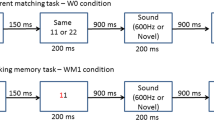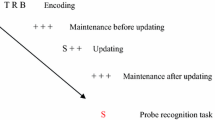Abstract
Younger adults generally perform better than older adults on memory tasks with reduced processing speed proposed as a mediating factor. However, processing speed often gets confounded with accuracy. To overcome this confound and quantify age-related changes in information processing speed, the current study used a specially developed computer program that held performance accuracy constant while measuring speed of processing. Twelve older (mean age = 77) and younger (mean age = 27) subjects participated in this study. Older subjects processed both visual (mean = 3860) and auditory (mean = 3400) information more slowly than did younger subjects (mean = 1680 and mean = 2070, respectively). No modality-specific differences in processing speed were present. Importantly, older subjects' mean accuracy levels were similar to that of younger subjects. These findings suggest that processing speed may be a critical determinant in working memory impairments in the elderly. However, individualized rates of information presentation could allow older subjects to perform as accurately as younger subjects.
Similar content being viewed by others
REFERENCES
Baddeley, A. (1986a). Working Memory, Oxford University Press, Oxford.
Baddeley, A. (1986b). Is working memory working? The Fifteenth Bartlett Lecture. Q. J. Exp. Psychol. 44a: 1-31.
Baddeley, A. D., and Hitch, G. J. (1994). Developments in the concept of working memory. Neuropsychology 8(4): 485-493.
Bashore, T. R., van der Molen, M. W., Ridderinkhof, R. K., and Wylie, S. A. (1997). Is the age-complexity effect mediated by reductions in general processing resource? Biolog. Psychol. 45: 1-3, 263-282.
Baum, K. M., Vanderploeg, R. D., and Curtiss G. (1996). Patterns of verbal memory deficits in traumatic brain injury using the CVLT. Clin. Neuropsychol. 10: 340.
Ben-Yishay, Y., Silver, S., Piasetsky, E., and Rattok, J. (1987). Relationship between employability and vocational outcome after intensive holistic cognitive rehabilitation. J. Head Trauma Rehabil. 2(1): 35-48.
Cavanaugh, J. C. (1983). Comprehension and retention of television programs by 20-and 60-year-olds. J. Gerontol. 38: 190-196.
Cerella, J., and Hale, S. (1994). The rise and fall in information-processing rates over the life span. Acta Psychol (Amst). Aug, 86: (2-3): 109-197. Review.
Craik, F. I. M. (1977). Age differences in human memory. In Birren, J. E., and Shaie, K. W. (eds.), Handbook of the Psychology of Aging, Van Nostrand Reinhold, New York, pp. 384-420.
Craik, F. I. M., and McDowd, J. M. (1987). Age differences in recall and recognition. J. Exp. Psychol. Learn. Mem. Cogn. 13: 474-479.
Daigneault, S., Braun, C. M. J., and Whitasker, H. A. (1992). Early effects of normal aging on preseverative and non-preseverative prefrontal measures. Dev. Neuropsychol. 88: 99-114.
DeLuca, J., Barbieri-Berger, S., and Johnson, S. K. (1994). The nature of memory impairments in multiple sclerosis: Acquisition versus retrieval. J. Clin. Exp. Neuropsychol. 16(2): 183-189.
DeLuca, J. Gaudino, E. A., Diamond, B. J., Christadoulou, C., and Engel, R. (1998). Acquisition and storage deficits in multiple sclerosis. J. Clin. Exp. Neuropsychol. 20(3): 376-390.
Diamond, B. J., DeLuca, J., Kim, H., and Kelley, S. M. (1997). The question of disproportionate impairments in visual and auditory information processing in multiple sclerosis. J. Clin. Exp. Neuropsychol. 19: 34-42.
Diamond, B. J., DeLuca, J., Kelley, S. M., and Gross, S. (1998). Processing speed, memory and executive function in Huntington's disease [Abstract]. J. Int. Neuropsychol. Soc. 4: 64-65.
Folstein, M. F., Folstein, S. E., and Mettugh, P. R. (1975). Mini-mental state. J. Psychiatr. Res. 12: 189-198.
Gathercole, S. E. (1994). Neuropsychology and working memory: A review. Neuropsychology 8: 494-505.
Golomb, J., Kluger, A., Gianutos, J., Ferris, S. H., de Leon J., Max, G., and Ajax, E. (1995). Nonspecific leukoencephalopathy associated with aging. Neurodegenerative Dis. 5(1): 33-44.
Gronwall, D. M. (1997). Paced auditory serial-addition task: A measure of recovery from concussion. Percept. Mot. Skills 44(2): 367-373.
Gronwall, D., and Wrightson, P. (1981). Memory and information processing capacity after closed head injury. J. Neurol. Neurosurg. and Psychiatry 44: 889-895.
Hart, T., and Hayden, M. (1986). The ecological validity of neuropsychological assessment and remediation. In Uzzell, B., and Gross, Y. (eds.), Clinical Neuropsychology of Intervention, Martinus Nijhoff, Boston.
Hasher, L., and Zacks, R. T. (1988). Working memory, comprehension and aging: A review and new view. In Bower, G. H. (ed.), The Psychology of Learning and Motivation, Vol. 22, Academic Press, San Diego, pp. 193-225.
Haut, M. W., Petros, T. V., Frank, R. G., and Haut, J. S. (1991). Speed of processing within semantic memory following severe closed head injury. Brain and Cognit. 17(1): 31-41.
Hultsch, D. F. (1975). Adult age differences in retrieval: Trace dependent and cue-dependent forgetting. Dev. Psychol. 11: 197-201.
Johansson, B. (1991). Neuropsychological assessment in the oldest old. Internat. Psychogeriat. 3: 51-60.
Johnson, S. K., DeLuca, J. Diamond, B. J., and Natelson, B. (1996). Selective impairment of auditory processing in Chronic Fatigue Syndrome: A comparison with multiple sclerosis and healthy controls. Percept. Mot. Skills 83: 51-62.
Katzman, R., and Terry, R. (1992). Normal aging of the nervous system. In Katzman, R., and Rowe, J. W. (eds.), Principle of Geriatric Neurology. F. A. Davis, Philadelphia, pp. 18-57.
Kluger, A., Gianutos, J., and de Leon, J. M. (1988). Significance of age-related white matter lesions. Stroke 19: 1054-1055.
Lebouvie-Vief, G., Shell, D. A., Campbell, S., Weaver, S., and Tannenhaus, M. (1979). Metaphoric processing in old and young adults. Paper presented at the annual meetings of the Gerontological Society, Washington, DC.
Levin, H. S., Goldstein, F., C., High W. M., and Williams, D. (1988). Automatic and effortful processing after severe closed head injury. Brain Cogn. 7: 283-297.
Madigan, N., DeLuca, J., Diamond, B. J., Tramontano, G., and Averill, A. (2000). Speed of information processing in traumatic brain injury: A modality-specific impairment? J. Head Trauma Rehabil. 5(3): 943-956.
McNaughton, B. L., and Morris, R. G. (1987). Hippocampal synaptic enhancement and information storage within a distributed memory system. Trends Neurosci. 10: 408-415.
O'Keefe, J. A. (1990). A computational theory of the hippocampal cognitive map. In Storm-Mathison, J., Zimmer, J., and Ottsersen, O. P. (eds.), Prog. Brain Res. 83: 301-312.
Poon, L. W. (1985). Differences in human memory with aging: Nature, causes and clinical implications. In Birren, J. E., and Shaie, K. W. (eds.), Handbook of the Psychology of Aging, 2nd Ed., Van Nostrand Reinhold, New York, pp. 427-462.
Poon, L. W. (1989). What do we know about the aging of cognitive abilities in everyday life? In Poon, L. W., Rubin, D. C., and Wilson, B. A. (eds.), Everyday Cognition in Adulthood and Late Life, Cambridge University Press, New York, pp. 129-132.
Rabbitt, P. (1964). Ignoring irrelevant information. British J. Psychol. 55(4): 403-414.
Rabbit, P. (1965). An age-decrement in the ability to ignore irrelevant information. J. Gerontol. 20: 233-238.
Salthouse, T. A. (1991). Mediation of adult age differences in cognition by reductions in working memory and speed of processing. Psychol. Sci. 2: 179-183.
Salthouse, T. A. (1996). General and specific speed mediation of adult age differences in memory. J. Gerontol. 51(1): 30-42.
Salthouse, T. A., and Babcock, R. L. (1991). Decomposing adult age differences in working memory. Develop. Psychol. 27(5): 763-776.
Salthouse, T. (1994). The nature of the influence of speed on adult age differences in cognition. Dev. Psychol. 30(2): 240-259.
Salthouse, T. (1992a). Influence of processing speed on adult age differences in working memory. Acta Psychol. 79: 155-170.
Salthouse, T. A. (1992b). What do adult age differences in the Digit Symbol Substitution test reflect? J. Gerontol. Psychol. Sci. 47: 121-128.
Stankov, L. (1988). Aging, attention and intelligence. Psychol. Aging 3: 59-74.
Weschsler, D. (1981). WAIS-R manual. New York: Psychological Corporation.
West, R. L. (1996). An application of prefrontal cortex function theory to cognitive aging. Psychol. Bull. Sep; 120(2): 272-292. Review.
Witter, M. P., Ostendorf, R. H., and Groenewegan, H. J. (1990). Heterogeneity in the dorsal subiculum of the rat: Distinct neuronal zones project to different cortical and subcortical targets. Eur. J. Neurosci. 2: 718-725.
Ylikoski, R., Ylikoski, A., Erkinjuntti, T., and Sulkava, R. (1993). White matter changes in healthy elderly persons correlate with attention and speed of processing. Arch. Neurol. 50(8): 818-824.
Ylikoski, R., Ylikoski, A., Erkinjuntti, T., Sulkava, R., Keskivaara, P., Raininko, R., and Tilvis, R. (1998). Differences in neuropsychological functioning associated with age, education, neurological status and magnetic resonance imaging finding in neurologically healthy elderly individuals. Appl. Neuropsychol. 5(1): 1-14.
Author information
Authors and Affiliations
Rights and permissions
About this article
Cite this article
Diamond, B.J., DeLuca, J., Rosenthal, D. et al. Information Processing in Older Versus Younger Adults: Accuracy Versus Speed. International Journal of Rehabilitation and Health 5, 55–64 (2000). https://doi.org/10.1023/A:1012911203468
Issue Date:
DOI: https://doi.org/10.1023/A:1012911203468




